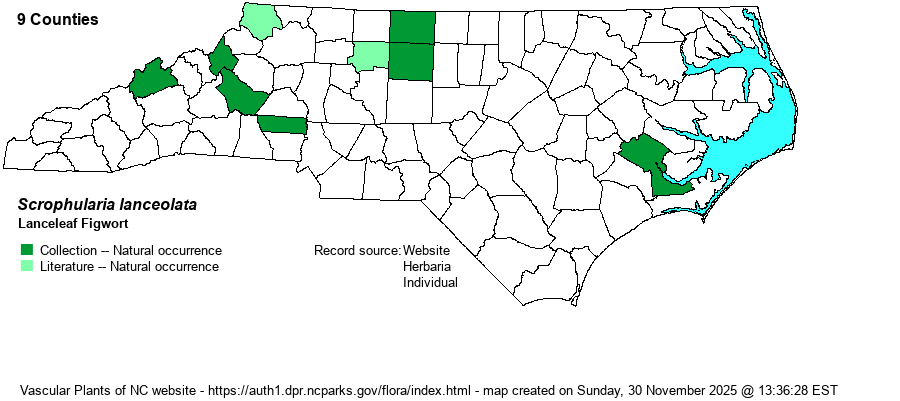| Author | Pursh | |
| Distribution | Poorly known, and remarkably confused for such a seemingly obvious plant species! A misidentified specimen of S. marilandica from Lincoln County, in 1969, was recently annotated to S. lanceolata. There are recent photos on iNaturalist from five counties (Avery, Ashe, Rockingham, Forsyth, and Guilford), and a few widely scattered specimens. Range is thus primarily limited to, but not exclusively to, the northern portions of the Mountains east to the north-central Piedmont.
This is a wide-ranging Northern species, ranging from Canada south to VA, IL, OK, NM, and northern CA. It occurs sparingly into NC, a few county records for SC; no records known for GA and very few for TN. | |
| Abundance | Puzzlingly very rare in NC, certainly under-collected or observed, or more likely overlooked or misidentified as the much more numerous and widespread S. marilandica (as several specimens were). This is a Significantly Rare species in the state. | |
| Habitat | One would think that the rarer of the two Scrophularia species in NC would have the more specific and scarce of the habitats in the state, but the opposite seems to be true. Whereas as S. marilandica occurs mostly on the infrequent high pH soil areas in the state, S.lanceolata occurs in typical dry to dry-mesic upland hardwood forests, probably over slightly acidic soils. The only reason for its scarcity in such common habitats must be that it favors cooler microclimates than regularly found in NC. However, one must wonder if the Craven (and possibly Jones) record was from a forested area over marl (high pH soil), as species usually disjunct from the Piedmont to those counties tend to be ones that grow on high pH soil. One website editor (Sorrie) has seen this species in several prairie and grassy woodland habitats in the Midwest; this suggests that in the East it originally may have occurred in prairie-like openings. | |
| Phenology | Blooms from May into early July, and fruits shortly after flowering. Note that S. marilandica flowers from mid-July onward, and thus the flowering of these two do not overlap. | |
| Identification | This is a fairly robust and tall species, growing to about 3-4 feet tall, often somewhat leaning. It has scattered opposite leaves, each on a long petiole about 1-inch in length. The leaf blade is ovate to ovate-lanceolate, about 4-5 inches long and about 2.5 inches wide, with quite large serrations. The top of the stem contains the wide open panicle, about 4-5 inches long and rather cylindrical --- about as wide at the bottom as near the top. There are several dozen small flowers, each looking like a small preacher standing in a pulpit; in this species, the flower is yellow-green on the outside and pale brown to reddish inside. The "preacher" is actually a sterile filament, and it is also yellow-green in this species, and it is purple-brown in the other. Thus, to separate these two, note that S. marilandica has very finely serrated leaves (each tooth less than 3 mm long), a pyramid-shaped panicle instead of more cylindrical, and a purple-brown sterile filament. Also note that S. marilandica does not begin blooming in the state until at least mid-July, after S. lanceolata should be finished. | |
| Taxonomic Comments | None
| |
| Other Common Name(s) | American Figwort, Early Figwort | |
| State Rank | S1 | |
| Global Rank | G5 | |
| State Status | SR-P | |
| US Status | | |
| USACE-agcp | FAC link |
| USACE-emp | FACU link |

